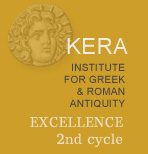Updated: 2021
Survey results in Boubon (Cibyratis, northern Lycia)
2004-2006
The ancient region known as the Cibyratis includes the site of the ancient city of Cibyra near modern Gölhisar in the Turkish province of Burdur and, to the south of Cibyra, the sites of Boubon, Balboura, and Oinoanda. To judge by their architectural remains, the four cities were unequal in size and importance. In the period best represented in our evidence, the Roman Imperial period, Cibyra was clearly the largest community in the region. It was followed in size by Oinoanda and Balboura, while Boubon must have been the smallest of the four cities. They had nevertheless formed a league (tetrapolis) in Hellenistic times, which persisted until the Roman general L. Murena forcibly dissolved their union in 84 CE.
Dikmen Tepe means
"upright" or
"vertical mountain"
in Turkish.
Bουβών can mean
"swelling" or "bulge"
in ancient Greek.The remains of Boubon are located on the steep side of a mountain some 20 km south of Gölhisar/Cibyra near the village İbecik. The mountain's distinct conical shape may account for its modern name, Dikmen Tepe, "upright" or "vertical mountain", and possibly also for its ancient name: in ancient Greek, βουβών can mean "swelling" or "bulge". The site is surrounded by hills and fertile fields formerly transected by minor tributaries of the river Indus (Dalaman). Today, an irrigation dam (Yapraklı Baraj) occupies a large area of the valley north of Dikmen Tepe and İbecik.
In late Hellenistic times, the city of Boubon appears to have been the site of origin of a dynasty that dominated large parts of the Cibyratis and played a role in the negotiations with the Romans after the defeat of the Seleucid king Antiochus III. Boubon apparently thrived in Roman Imperial times as one of the numerous communities--Pliny mentions 36--of the Lycian koinon. A small independent polis, Boubon has yielded the most remarkable group of bronze statues ever found in the eastern Roman empire, which have been interpreted by the Turkish archaeologist Jale İnan as depictions of Roman emperors presumably displayed in a small structure at the main site of the city, in all probability a sebasteion.
Boubon has also yielded an important stone inscription concerning the internal organization of the Lycian League in the third cent. CE and its relations with Imperial power. This document (no. 5) preserves a letter by the emperor Commodus in praise of the league's decision to include Boubon among the cities that had three votes in the national assembly, in spite of its small size, as a reward to Boubon for its role in combating bands of brigands. Three votes in the assembly were the maximum number allowed to a member city, and hence the league’s decision placed this small mountain community on a par in this respect with such famous Lycian cities as Xanthos and Patara.
The site of Boubon has attracted little attention in scholarship, receiving only cursory references in previous publications on the region. The settlement had been previously described only in very summary accounts by G. E. Bean and other travelers. Apart from small-scale rescue excavations of two buildings in the area of the agora, there has been no archaeological investigation of the city or its territory, both of which have been the target of systematic looting, predominantly in the 1960s.
This website offers a preliminary presentation of the results of three survey campaigns conducted in Boubon and its territory in 2004-2006 as part of the Cibyratis Project of the University of Heidelberg under the direction of Thomas Corsten (now Vienna) in collaboration with Christina Kokkinia of the Institute of Historical Research of the National Hellenic Research Foundation in Athens. It includes a corpus of the inscriptions found in Boubon and its territory, 15 of which are published here for the first time. Though our main interest lay in the epigraphy of the region, we have attempted, on the evidence of surface finds, to document the archaeological remains as thoroughly as possible. The contribution of Oliver Hülden has been invaluable to this end.
Our brief initial campaign in August 2004 was dedicated entirely to the recording of inscriptions at the site and in its immediate surroundings, mostly in İbecik, Elmalı Yurt, and Pazar Yeri. Expecting our epigraphic finds to be fewer in 2005, our priority shifted then to surveying the archaeological remains in the city and its territory. Our main focus in 2006 lay on the ancient settlement of Boubon. Secondarily, our work extended to examination of the various fortified locations in the near vicinity of the settlement. In 2006 we were also able to make use of a Total Station to take precise measurements of pertinent distances.
Topographic maps drawn at the Department of Geomatics of the University of Karlsruhe, as well as detailed discussion of the archaeological remains and a revised edition of the epigraphic corpus, have been included in the print version of this report which appeared in summer 2008 in the series ΜΕΛΕΤΗΜΑΤΑ : Christina Kokkinia (ed.), Boubon. The Inscriptions and Archaeological Remains. A Survey 2004-2006, Athens 2008 [Meletemata 60 (p. x, 193, XXIII pl., 1 fold. map.) ISBN 960-7905-47-5].
Between 2008 and 2014, archaeological field research in the Cibyratis, including Boubon and its territory, continued under the direction of Thomas Corsten and Oliver Hülden. With support from the Gerda-Henkel Foundation, an online publication of the results of these campaigns, including unpublished ceramic finds from the campaign of 2006, is now available here.
Christina Kokkinia

